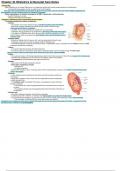-
1. Class notes - Chapter 5: medical terminology
-
2. Class notes - Chapter 10: patient assessment
-
3. Class notes - Chapter 13: shock
-
4. Class notes - Chapter 11: airway management
-
5. Class notes - Chapter 14: bls resuscitation
-
6. Class notes - Chapter 15: medical overview
-
7. Class notes - Chapter 12: principles of pharmacology
-
8. Class notes - Ch 41 terrorism response and disaster management
-
9. Class notes - Chapter 28: face & neck injuries
-
10. Class notes - Chapter 34: obstetric & neonatal care
-
11. Class notes - Chapter 37 patients with special challenges
-
12. Class notes - Ch 31 abdominal - genitourinary injuries
-
13. Class notes - Ch. 30 chest injuries
-
14. Class notes - Ch. 21 allergy - anaphylaxis
-
15. Class notes - Ch. 22 toxicology
-
16. Class notes - Ch 20 endocrine - hematologic emergencies
-
17. Class notes - Ch 29 head - spine injuries
-
18. Class notes - Ch 32 orthopaedic injuries
-
19. Class notes - Ch 36 geriatric emergencies
-
20. Class notes - Ch 17 cardiovascular emergencies
-
21. Class notes - Ch 16 respiratory emergencies
-
22. Class notes - Ch 38 transport operations
-
23. Class notes - Ch 33 environmental emergencies
-
24. Class notes - Ch 35 pediatric emergencies
-
25. Class notes - Ch 26 bleeding
-
26. Class notes - Ch 27 soft tissue injuries
-
27. Class notes - Ch 23 behavior health emergencies
-
28. Class notes - Ch 39 vehicle extrication and special rescue
-
29. Class notes - Ch 25 trauma overview
-
30. Class notes - Ch 18 neurologic emergencies
-
31. Class notes - Ch 19 gi - urologic emergencies
-
32. Class notes - Ch 24 gynecologic emergencies
-
33. Class notes - Ch 40 incident management
-
Show more




